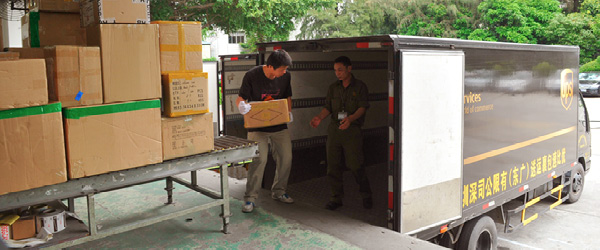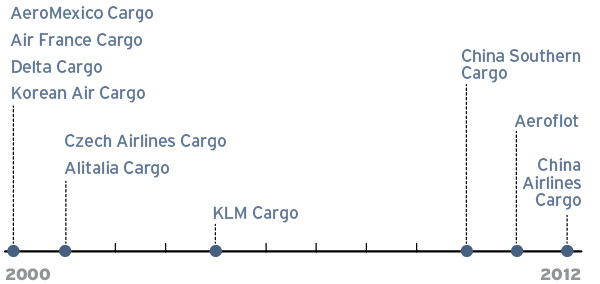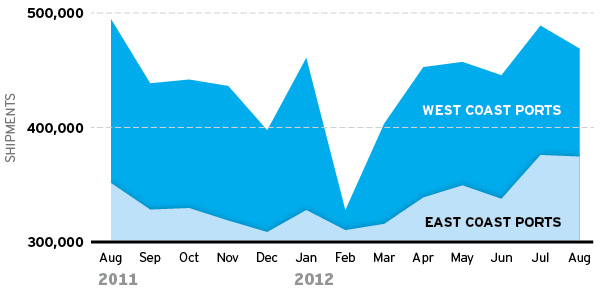Global Logistics—October 2012

China Opens Door-to-Door Delivery to FedEx, UPS
Federal Express officially contracted its name to FedEx in 2000 to facilitate an easier translation as it expanded the brand globally. United Parcel Service (UPS) has built similar acronym appeal and currency in the countries where it operates. So China’s recent decision to grant both couriers authority to provide express package delivery services in select Chinese cities will increase their household name exposure in the world’s most populous country.
The licenses allow the two companies to serve Shanghai, Guangzhou, Shenzhen, and Tianjin. In addition, FedEx was approved for Hangzhou, Dalian, Zhengzhou, and Chengdu, while UPS can also operate in Xian.
While the global recession has impacted export trade, China has been busy investing in and manufacturing to its expanding middle class—which demands better network density and service capabilities to keep pace with domestic growth. Currently, state-owned China Postal Express & Logistics controls 30 percent of the market. Stoking competition where the government specifies can only raise service standards and expectations.
The easiest way to do that is to import the experience and expertise of companies such as FedEx and UPS. They, in turn, will be able to provide true end-to-end services and visibility to customers operating in China, rather than coordinating with local partners.
Both companies are familiar with Asian expansion. FedEx entered China in 1989 with the acquisition of Flying Tigers and routes to 21 Asian countries. And in 2007, it spent $400 million to take over a joint venture with Tianjin Datian W. Group Co., which offered access to China’s domestic market. UPS is in the process of buying TNT Express, which includes a well-developed road network throughout Asia.
Alibaba Antes Up Logistics Investment
The e-commerce revolution has swept through the United States, and radically changed the way companies equip warehouses, align distribution networks, and execute order fulfillment. So consider the challenge China now faces as online shopping phenomenon Alibaba Group takes hold of a population four times the size.
The country’s middle-class consumption has been growing at a robust clip—even more so as the government stimulates domestic growth absent steady export volumes. Now, with e-commerce emerging as a new channel for consumers to buy goods, demand for warehouses and parcel delivery services is far outpacing the development of transportation and logistics infrastructure.
Alibaba, China’s foremost online shopping platform, is under pressure to scale its operations and resources to react to this new demand. In 2012, the company expects to sell merchandise worth more than that sold by Amazon and eBay combined, and is forecasting $473 billion in annual transactions over the next five to seven years from its Taobao e-commerce units alone.
Like Amazon did earlier in 2012 with the acquisition of Kiva Systems and its robotic materials handling solution, Alibaba is looking to act as its own change agent within China. The company is seeking to invest a total of $100 million in Chinese logistics firms—including a warehouse operator and a parcel delivery company—by the end of 2012.
While the company publicly stated it has no intention of making any acquisitions, some speculate that Alibaba may be looking at the logistics sector as another area for growth, while also supporting its own core business.
Alibaba is facing new competition from other Chinese Internet companies, notably 360buy, providing incentive to improve service with better and faster delivery capabilities. To point, Alibaba is already moving ahead with plans to build a regional network of six to eight mega-warehouses across China.
U.S. Import Shipments Into East and West Coast Ports
Imports on both U.S. coasts show a recent upward trend, as importers stock up before the holiday rush. The threat of a port workers strike, however, worried many in August.
Source: Zepol Corporation
Vietnam Lacks Logistics Talent
Among Southeast Asia’s logistics hotspots, Vietnam’s star has been on the rise for some time. The country is a favored destination for labor-intensive, low-cost manufacturing activity, and Ho Chi Minh has emerged as a Top 50 cargo port in the world, according to American Association of Port Authorities statistics.
But one challenge of rapid economic development is nurturing the transportation and logistics talent and expertise necessary to support continued growth. Vietnam now faces a dearth of qualified professionals in the freight industry, according to officials at the Vietnam Freight Forwarders Association (VIFFAS).
The shortage comes as Vietnam looks to capitalize on an advantageous maritime location and grow its presence as a freight transshipment hub. Though the government has made a concerted effort by investing in transportation and logistics infrastructure to facilitate cargo flows and attract manufacturing and distribution business, VIFFAS anticipates a shortfall of 18,000 skilled professionals in the logistics services sector over the next three years. Currently, the supply of human resources represents 40 percent of demand.
To help fill the gap, various efforts are underway to help publicize and promote logistics as a career path. Additionally, there is impetus to create a formalized university dedicated to grooming management talent, as well as develop a long-term national strategy that would outline funding and technical support to drive such an effort.
Taiwan’s Flagship Carrier Joins SkyTeam Cargo Alliance
The current global economic malaise has had a marked impact on the air cargo industry, especially given the premium placed on airfreight services and the increasing sophistication and predictability of supply chains that allow for longer lead times and slower mode shifts. Like ocean freight, airlines are relying on strategic partnerships to share resources and hedge risk. China Airlines Cargo’s recent agreement to join the SkyTeam Cargo Alliance as its 10th member (see chart below) points to the utility of such collaborative arrangements amid a challenging marketplace.

The SkyTeam Cargo alliance was initiated in 2000 through the collaboration of its four founding members—AeroMexico Cargo, Air France Cargo, Delta Cargo, and Korean Air Cargo. In the past decade, the alliance has expanded its global presence with the addition of six carriers.
Speaking to attendees at The International Air Cargo Association’s annual forum and exhibition, Oct. 2-4, 2012, in Atlanta—where the China Airlines’ agreement was officially announced—SkyTeam Cargo representatives reinforced the alliance’s mission. Members are able to align their diverse resources and capabilities to provide shippers and forwarders with a more comprehensive and standardized portfolio of services and coverage. This includes operational synergies and seamless transfers between different carriers; a consistent focus on safety, security, and sustainability; shared warehousing; the development of vertical-specific and time-definite product offerings across the entire network; and, with regards to the International Air Transport Association’s e-freight initiative, a more economical and concerted approach to implementing and executing a paperless air cargo supply chain.
As the flagship carrier of Taiwan, China Airlines expands SkyTeam Cargo’s global reach with its extensive route network throughout Asia, Europe, North America, and Oceania. It also provides the alliance with another Asian partner that can help facilitate regulatory and operational synergies between continents. For example, on the e-freight initiative, with cooperation from China Airlines, China Southern Cargo, and Chinese Customs, SkyTeam Cargo will soon pilot a trial shipment to and from Amsterdam and China. As with other aspects of the alliance, all members benefit as individual carriers innovate and develop new capabilities.
The collaborative e-freight effort presents a microcosm for SkyTeam Cargo’s broader mission—to bring air cargo partners under one roof and provide shippers with a one-stop shop for seamless airfreight service around the world.

